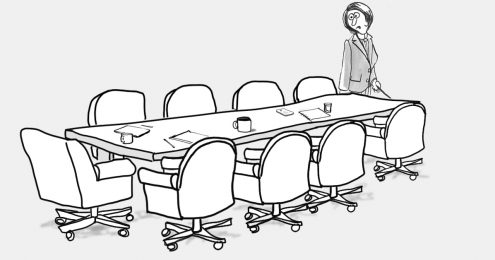Do me a favor. Stop for a second and chew on this question: What motivates you to do a great job?
Is it the warm sense of accomplishment you get when you achieve a goal?
Or maybe you love the satisfaction of being able to say, “I did that thing!” — especially when that thing is something that you once considered impossible.
Now imagine your kid (or another youngster in your life) comes home from school with a test grade. They went the extra mile and worked and studied really really hard — and got an 87.
Do you go through the wrong answers with phrases like, “Oh, that was an easy one – you should have had that” or “With an extra hour of studying and you’d have cracked 90”?
Or do you celebrate their hard-earned 87?
I feel like a lot of staff leaders choose the first option when their board members get 87s…
You know, those times when they don’t exactly hit it out of the park, but at least you know it wasn’t due to a lack of trying?
I think far too often, staff leaders nag board members to study harder, to practice the foreign language that doesn’t come so easily to them.
Now I’m not talking about board members who are MIA, toxic, or those who have joined your board only to advance their career or boost their ego.
I’m talking about the rock stars who are always there for you, who initiate, and who lead. The folks who really try hard and are very busy but will step up if you ask.
These folks who often get painted with the same brush as toxic board members when executive directors have an expectation that all of them should get 94s instead of 87s.
You see it most when EDs nag their boards for more ticket sales, more big-ticket donors, or more work hours.
I think we do a lousy job of appreciating board members. Like really lousy.
You see, if you want high-performing board members, you have to motivate them. You have to celebrate the 87s.
So I reached out to members of our Nonprofit Leadership Lab to see if I could motivate folks to exercise this board gratitude muscle. To my delight, I was overwhelmed with responses. And I’d like to share them with you.
Not only will this give you some ideas on how you can offer more positive feedback to your board, but it will also give you a glimpse of what a high-performing board actually looks like.
THE 6 ATTRIBUTES OF A HIGH-FUNCTIONING BOARD (AND WHY YOU SHOULD BE THANKFUL IF A BOARD MEMBER HAS AT LEAST ONE ATTRIBUTE)
A high-functioning board can be a real game-changer for your org — especially if you are at a smaller nonprofit. There are six main attributes that every high-functioning board member brings to the table. And they came up over and over again in the responses I got from Lab members.
As you’ll see, I’ve organized their gratitude by these attributes so you can really see how much of an impact each one truly makes when a board member brings them to the work.
1. They are passionate ambassadors.
A high-functioning board is filled with enthusiastic storytellers who ignite passion in others and are always eager to invite more folks to know more and do more for your organization.
Here’s what some of our lab members have to say about their most passionate ambassadors:
“She is terrified to do public speaking but she is so passionate, seeing the glass as half full. She changes the atmosphere in the room at an event with her energy and passion.”
”My board members are so incredibly passionate about the work we do. They give up nights and weekends for meetings, strategic planning and are in the trenches doing the work and are committed to seeing us grow.”
“She sings our praises to every person she meets.”
“I am a board member and our board chair is a movement builder and has a vision for the future. Her passion for the work has given us all the shot of energy and direction we needed. I feel absolutely psyched every time I have the chance to work with her.”
2. They bring expertise, engagement, and thought partnership to the table.
If you read anything that I write, then you know that I’m always talking about how a thriving nonprofit is like a twin-engine jet. The board and staff must engage and work as co-pilots — and meet each other at the right altitude.
Here’s what a board that leads with the ED looks like:
“My treasurer is an angel. She is a retired CPA and so dedicated. She does so much more than our books. She is a problem solver and willing to do whatever it takes for us to be successful. Her wisdom and experience are invaluable.”
“I began as E.D. just last year and our newest board member has worked for a national nonprofit for years and sends me resources, articles, and information whenever she becomes aware of something I am working on. She is a real thought partner and I know our organization is always top of mind for her.”
“Two board members in particular offer their expertise regularly and save the organization tons of money.”
“One board member offers business advice and can walk me through potential pitfalls I have not thought of. In fact, I have three board members I can really count on in this way – to ask critical questions and see the big picture. I would not be nearly as effective without their critical insight.”
“I have an amazing board. They do not rubber-stamp everything I recommend. They offer direction and expertise AND stay in their lane.”
“I am ready to move to a new role soon — the one thing holding me back is the relationship I have with my board chair. Maybe I can take him with me!”
3. They make great diplomats.
No one loves difficult conversations — but they are a fact of life. And a great board member comes with the skill set and mindset to face them without feeling terrified.
High-functioning board members are pros at reading people, have strong EQ, and can help you and your staff navigate sticky situations and tough conversations with everyone from your donors to your volunteers.
Here are some great examples of this kind of diplomacy in action:
“My amazing board member makes magic happen frequently. She is highly respected by the other members and is oftentimes my voice to the board if/when we have a sticky situation or action is needed.”
“I am one of those Executive Directors who is always drawn to the “next shiny new thing” and they bring me back to reality without bursting my bubble.”
“When I began, our organization had some bridge-building to do. One board member used his influence to change many hearts and minds.”
“I have a board member who is all about relationships, recently negotiating with our landlord on our behalf, softening the landlord’s heart about our work enough to contribute to pay for improvements.”
4. They help you grow your army of the engaged.
For a nonprofit (and especially a small one), people = power.
You need as many diverse people in your corner as possible who know about your organization and are pumped to champion your cause. This army of engaged supporters is always ready to mobilize, to volunteer, and to give.
And your board plays a key role in helping you share your org’s story, bringing more people closer to your work, and inviting people to join the party.
Check out how these board members are making an impact in this area:
“The board chair fearlessly and unapologetically brings the mission to life in her own workplace.”
“My board chair has brought numerous big donors in as she touches the hearts and minds of those with means within her professional circle.”
“I have a 70 year old board member who has more energy than a 20 year old. He created a list of contacts that he thought would be great potential donors and has systematically been approaching each of them over the last few months, even traveling to see them!”
“My current and former Board Chairs are exceptional. They fully understand our cause, have wide board experience and know tons of people.”
“She is great at filling and filtering the funnel and shepherding stakeholders into matching opportunities.”
“My favorite board member consistently brings meaningful, aligned opportunities to my attention and makes an effort to ensure that we have the resources to pursue them.”
5. They are great co-pilots.
With a high-functioning board working at your side, it never feels like you are flying solo. As I mentioned earlier, leading a nonprofit is like a twin engine jet — your board members are your copilots.
Great board members bring their most relevant and valuable skills, experiences, connections, and ideas to the table to help you make the big decisions every day and create a long-term vision for your organization.
“Our board chair is ending her three year leadership and I cannot imagine life without her next to me as my co-pilot. She has grown and learned so much and was always willing to try new approaches to problem solving.”
6. They provide moral support.
It’s no secret — nonprofit executive directors have very hard jobs. And they tend to take care of themselves last (if at all). But whether it is by taking a task off of your plate or simply encouraging you to take a break, a high-functioning board is always there to support you through the most challenging times.
Why? Because they care about your staff, they care about your mission, and they care about you.
Like these board members:
“Every time we talk, he wants to know how I am doing (not the organization)”
“My board chair cares about me and my team on a personal level, showing up for my office manager’s retirement dinner and a memorial service for my husband. He’ll show up with a box of pastries just because. I know he cares about our well being and not just how much work we do.”
GO THANK YOUR NONPROFIT BOARD MEMBERS (RIGHT NOW)
Did any of the gratitude included above remind you of anyone on your board? Now is a great time to reach out and thank them. Let them know how much you appreciate their commitment to your mission. It just might be the motivation they need to stay ignited and excited about the work.
Board service is a really hard job to get right, so I hope this post inspires you to give your board members some grace. Even if your board is not scoring straight A’s across the board right now, consider that maybe today’s B+ was yesterday’s F. And you should also keep in mind that these board members said YES when asked to join your board when they could have said no. Each and every one of them wants to be a high-performing board member on a high-performing board.
Maybe all your board needs is a little support, or perhaps a good “tune-up”. Maybe there are certain skills, attributes, and experiences missing from your board table that would really take your board to the next level.
You don’t have to figure this stuff out all on your own. My newest workshop can help you answer all of these questions and so many more that you probably have about your nonprofit board.
Join me to learn the 3 steps that will transform your board from low-performing to HIGH-FUNCTIONING and learn exactly how to design and build the nonprofit board of your dreams from start to finish.
You will also get a few bonus tools that will help you assess your existing board’s strengths and weaknesses and design your dream board with intention.
Click here to save your seat today!



